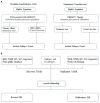Causal relationship among obesity and body fat distribution and epilepsy subtypes
- PMID: 36388204
- PMCID: PMC9644162
- DOI: 10.3389/fneur.2022.984824
Causal relationship among obesity and body fat distribution and epilepsy subtypes
Abstract
Objective: The observational studies indicate an association between obesity and epilepsy, but it is unclear whether such an association responds to causality. The objective of this study was to determine the causal relationship between obesity and fat distribution and epilepsy subtypes based on waist circumference, hip circumference (HP), waist-hip ratio (WHR), and body mass index (BMI).
Methods: A two-sample Mendelian randomization study was conducted separately for the four indicators of obesity and epilepsy and its seven subtypes, with reverse Mendelian randomization and multivariate Mendelian randomization for significant outcomes.
Results: A two-sample Mendelian randomized analysis informed us that waist circumference was a risk factor for juvenile myoclonic epilepsy (beta = 0.0299, P = 4.60 × 10-3). The increase in hip circumference increased the risk of juvenile myoclonic epilepsy and epilepsy, with effect values of 0.0283 (P = 2.01 × 10-3) and 0.0928 (P = 1.40 × 10-2), respectively. Furthermore, children with a higher BMI exhibit a higher risk of epilepsy (beta = 0.0148 P = 1.05 × 10-3). The reverse Mendelian randomization study revealed that childhood absence epilepsy increased its BMI (beta = 0.8980, P = 7.52 × 10-7), and juvenile myoclonic epilepsy increased its waist circumference (beta = 0.7322, P = 3.26 × 10-2). Multivariate Mendelian randomization revealed that an increase in hip circumference and waist-hip ratio increased the risk of juvenile myoclonic epilepsy, with an effect value of 0.1051 (P = 9.75 × 10-4) and 0.1430 (P = 3.99 × 10-3), respectively, while an increase in BMI and waist circumference instead decreased their risk, with effect values of -0.0951 (P = 3.14 × 10-2) and-0.0541 (P = 1.71 × 10-2). In contrast, multivariate Mendelian randomization for childhood absence epilepsy and epilepsy did not identify any independent risk factors.
Significance: Our findings provide novel evidence in favor of obesity as a risk factor for epilepsy and waist circumference as a risk factor for juvenile myoclonic epilepsy. Increased hip circumference confers an elevated risk of juvenile myoclonic epilepsy and epilepsy (all documented cases), and a high BMI increases the risk of childhood absence epilepsy. With this, new insights are provided into the energy metabolism of epilepsy, which supports further nutritional interventions and the search for new therapeutic targets.
Keywords: Mendelian randomization analysis; causation; epilepsy; fat distribution; obesity.
Copyright © 2022 Zhou, Yang, Chen, Wang and Qu.
Conflict of interest statement
The authors declare that the research was conducted in the absence of any commercial or financial relationships that could be construed as a potential conflict of interest.
Figures
Similar articles
-
Maternal central obesity and birth size: a Mendelian randomization analysis.Lipids Health Dis. 2018 Jul 31;17(1):181. doi: 10.1186/s12944-018-0831-4. Lipids Health Dis. 2018. PMID: 30064420 Free PMC article.
-
Obesity, Visceral Adipose Tissue, and Essential Hypertension: Evidence From a Mendelian Randomization Study and Mediation Analysis.J Clin Hypertens (Greenwich). 2025 Apr;27(4):e70045. doi: 10.1111/jch.70045. J Clin Hypertens (Greenwich). 2025. PMID: 40259745 Free PMC article.
-
The causal effect of obesity on diabetic retinopathy: A two-sample Mendelian randomization study.Front Endocrinol (Lausanne). 2023 Apr 3;14:1108731. doi: 10.3389/fendo.2023.1108731. eCollection 2023. Front Endocrinol (Lausanne). 2023. PMID: 37077358 Free PMC article.
-
Causal relationship of obesity and adiposity distribution on risk of ventral hernia.World J Surg. 2024 May;48(5):1141-1148. doi: 10.1002/wjs.12137. Epub 2024 Mar 23. World J Surg. 2024. PMID: 38520680
-
Causal analysis of body composition measurements in osteoarthritis knee: a two-sample mendelian randomization study.BMC Musculoskelet Disord. 2024 Apr 29;25(1):341. doi: 10.1186/s12891-024-07465-3. BMC Musculoskelet Disord. 2024. PMID: 38684987 Free PMC article.
Cited by
-
Genetic associations between ULK3 and epilepsy: a two-sample Mendelian randomization study.Front Neurol. 2024 Aug 12;15:1376314. doi: 10.3389/fneur.2024.1376314. eCollection 2024. Front Neurol. 2024. PMID: 39188705 Free PMC article.
-
The relationships between obesity and epilepsy: A systematic review with meta-analysis.PLoS One. 2024 Aug 9;19(8):e0306175. doi: 10.1371/journal.pone.0306175. eCollection 2024. PLoS One. 2024. PMID: 39121110 Free PMC article.
-
Mendelian randomization study shows a causal effect of asthma on epilepsy risk.Front Immunol. 2023 Feb 13;14:1071580. doi: 10.3389/fimmu.2023.1071580. eCollection 2023. Front Immunol. 2023. PMID: 36860869 Free PMC article.
-
Skin Microbiota, Circulating Metabolic Biomarker, Epilepsy: A Mendelian Randomization Analysis.Curr Issues Mol Biol. 2024 Dec 11;46(12):13937-13950. doi: 10.3390/cimb46120833. Curr Issues Mol Biol. 2024. PMID: 39727961 Free PMC article.
-
Neurobehavioral Comorbidities in Canine Idiopathic Epilepsy: New Insights into Cognitive and Emotional Domains.Animals (Basel). 2025 May 29;15(11):1592. doi: 10.3390/ani15111592. Animals (Basel). 2025. PMID: 40509058 Free PMC article.
References
Publication types
LinkOut - more resources
Full Text Sources
Research Materials
Miscellaneous



